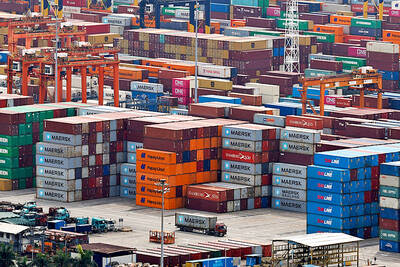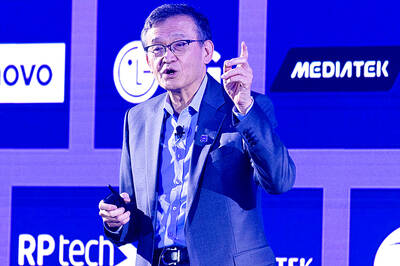The nation lags behind China in developing Internet banking because regulators are less tolerant of financial innovations that may upset the traditional banking ecosystem, Greg Gibb, chairman of the Shanghai Lujazui International Financial Asset Exchange Co, said yesterday.
Gibb, founder of Lufax.com, a peer-to-peer lending platform under China’s Ping An Group (中國平安), said the platform is the world’s third-largest P2P firm just two years after its formation, thanks to regulatory tolerance and the prevalence of the Internet and smartphones.
Peer-to-peer lending, also known as person-to-person lending and abbreviated to P2P lending, is the practice of lending money to unrelated individuals or peers without going through a traditional financial intermediary such as a bank.
Lending is transacted online on a host Web site using various lending platforms and credit checking tools. P2P lending is growing fast in many countries and China stays ahead in this market as the number of Internet users is increasing rapidly and regulatory restrictions are largely absent, said Gibb, who used to be chief operating officer at Taishin Financial Holding Co (台新金控).
There were 1,000 P2P companies in China as of last year with transactions totaling 105.8 billion yuan (US$17.03 billion), including 26.8 billion in deposits and 68.03 billion in loans, Gibb said.
Taiwan may not see a big breakthrough in the next three years as regulators are conservative about financial innovation, even though the government constantly underscores the importance of innovation, Gibb said, adding that the overcrowded and fragmented market helps limit bold and competitive strategies.
China allows non-traditional innovation and takes regulatory action only when necessary, he said.
That helps explain why China’s e-commerce agent Alibaba Group Holding Ltd (阿里巴巴) and its online payment affiliate, Alipay.com Co (支付寶) have expanded so fast, and risen to a globally dominant position, Gibb said.
“Greater market tolerance fosters better discipline among companies,” he said, whereas Taiwanese regulators have implemented detailed restrictions to slow e-commerce.
In addition, the large difference in interest margins between traditional banks and underground lenders provides business opportunities for P2P companies, Lufax.com vice president Hurbert Tai (戴修憲) said.
Chinese banks set interest rates at about 8 percent, but shadow banking firms may charge 30 percent to 40 percent.
Aware of the high credit risk linked to innovation, Gibb said he would not be surprised if 80 percent of P2P companies folded, as quite a few have exited the market, mainly because of reckless operations and loose credit analyses.
Lufax has managed to avoid the mistakes by using big data to analyze the credit profiles of potential clients, Gibb said.

The Eurovision Song Contest has seen a surge in punter interest at the bookmakers, becoming a major betting event, experts said ahead of last night’s giant glamfest in Basel. “Eurovision has quietly become one of the biggest betting events of the year,” said Tomi Huttunen, senior manager of the Online Computer Finland (OCS) betting and casino platform. Betting sites have long been used to gauge which way voters might be leaning ahead of the world’s biggest televised live music event. However, bookmakers highlight a huge increase in engagement in recent years — and this year in particular. “We’ve already passed 2023’s total activity and

Nvidia Corp CEO Jensen Huang (黃仁勳) today announced that his company has selected "Beitou Shilin" in Taipei for its new Taiwan office, called Nvidia Constellation, putting an end to months of speculation. Industry sources have said that the tech giant has been eyeing the Beitou Shilin Science Park as the site of its new overseas headquarters, and speculated that the new headquarters would be built on two plots of land designated as "T17" and "T18," which span 3.89 hectares in the park. "I think it's time for us to reveal one of the largest products we've ever built," Huang said near the

China yesterday announced anti-dumping duties as high as 74.9 percent on imports of polyoxymethylene (POM) copolymers, a type of engineering plastic, from Taiwan, the US, the EU and Japan. The Chinese Ministry of Commerce’s findings conclude a probe launched in May last year, shortly after the US sharply increased tariffs on Chinese electric vehicles, computer chips and other imports. POM copolymers can partially replace metals such as copper and zinc, and have various applications, including in auto parts, electronics and medical equipment, the Chinese ministry has said. In January, it said initial investigations had determined that dumping was taking place, and implemented preliminary

Intel Corp yesterday reinforced its determination to strengthen its partnerships with Taiwan’s ecosystem partners including original-electronic-manufacturing (OEM) companies such as Hon Hai Precision Industry Co (鴻海精密) and chipmaker United Microelectronics Corp (UMC, 聯電). “Tonight marks a new beginning. We renew our new partnership with Taiwan ecosystem,” Intel new chief executive officer Tan Lip-bu (陳立武) said at a dinner with representatives from the company’s local partners, celebrating the 40th anniversary of the US chip giant’s presence in Taiwan. Tan took the reins at Intel six weeks ago aiming to reform the chipmaker and revive its past glory. This is the first time Tan